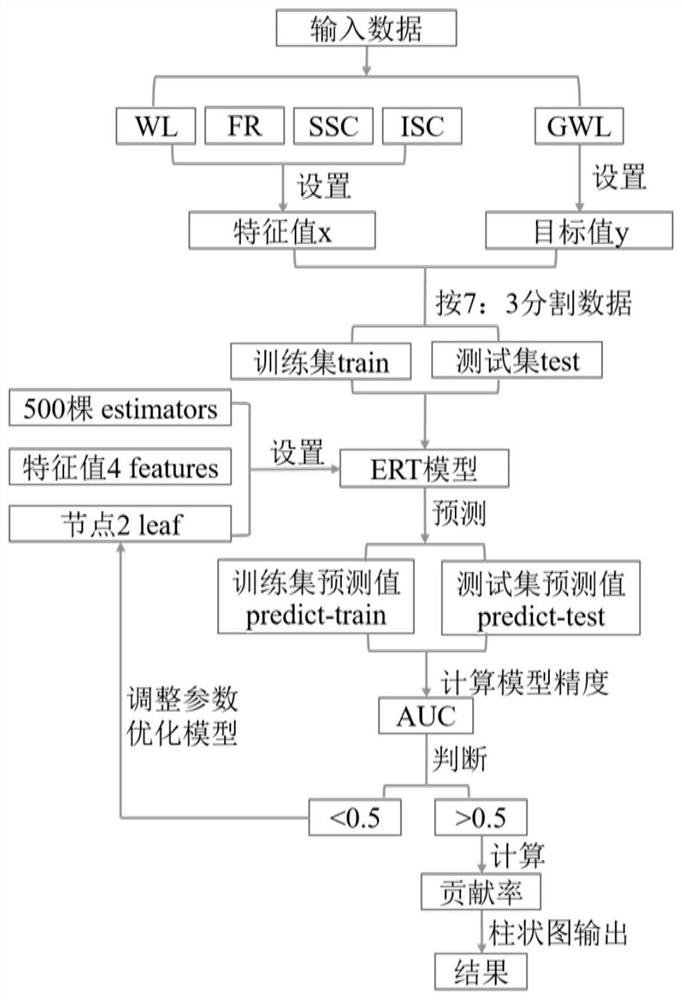Method for determining lagging response time of mutual conversion of river water and underground water under influence of river water and sediment regulation
A technology of response time and mutual conversion, applied in general water supply saving, design optimization/simulation, instruments, etc., can solve difficult lag time and other problems, and achieve the effects of short time consumption, wide application range and high controllability
- Summary
- Abstract
- Description
- Claims
- Application Information
AI Technical Summary
Problems solved by technology
Method used
Image
Examples
Embodiment 1
[0041] Such as figure 1 As shown, the present invention provides a method for determining the lag response time of river water and groundwater mutual transformation under the influence of river water and sediment regulation, comprising the following steps:
[0042] S101: Collect and process river and groundwater data;
[0043] Specifically, obtain the water and sediment parameter data of the first hydrological station and the second hydrological station, and the groundwater level data of each monitoring well between the first hydrological station and the second hydrological station; the water and sediment parameter data include water level, path Flow, sediment concentration and incoming sediment coefficient data.
[0044] S102: Based on the extreme random tree model, determine the main water and sediment factors that affect the change of groundwater level outside the river;
[0045] Specifically, the contribution rates of water level, runoff, sediment concentration and incom...
Embodiment approach
[0046] As an implementable manner, the following sub-steps are specifically included:
[0047] S1021: Set water level, runoff, sediment concentration and incoming sediment coefficient as characteristic values, and set GWL as target value;
[0048] S1022: divide the river and groundwater data into a training set and a test set;
[0049] S1023: In the extreme random tree classifier, set the number of trees to 500, the maximum feature value to 4, and the number of nodes to 2 to generate an extreme random tree model;
[0050] S1024: In the generated extreme random tree model, respectively predict the predicted values of the training set and the test set by simulating the measured values of the training set and the test set;
[0051] S1025: Combine the measured values and predicted values of the training set and the test set to calculate the AUC value, if AUC0.5, then Output the contribution rate of the feature value to the target value.
[0052] S103: Domesticate the or...
Embodiment 2
[0067] 1) Data collection and processing
[0068] This case selects the water and sediment parameter data of Huayuankou Hydrological Station (HYK) and Jiahetan (JHT) Hydrological Station in the lower reaches of the Yellow River from 1983 to 2015, including water level (WL), runoff (FR), sediment concentration (SSC) and Sand Coefficient (ISC) data; and groundwater level data from 4 monitoring wells YY1, ZM18, FQ12 and KF10 outside the channel between Huayuankou Hydrological Station and Jiahetan Hydrological Station. The above water and sand parameters and groundwater level data were all obtained from the Water Situation Daily website of the Yellow River Water Conservancy Commission and the Yellow River Statistical Yearbook. By matching and combining the water and sediment parameter data of Huayuankou hydrological station with the groundwater level data of YY1 and ZM18, and combining the water and sediment parameter data of Jiahetan hydrological station with the groundwater leve...
PUM
 Login to View More
Login to View More Abstract
Description
Claims
Application Information
 Login to View More
Login to View More - R&D
- Intellectual Property
- Life Sciences
- Materials
- Tech Scout
- Unparalleled Data Quality
- Higher Quality Content
- 60% Fewer Hallucinations
Browse by: Latest US Patents, China's latest patents, Technical Efficacy Thesaurus, Application Domain, Technology Topic, Popular Technical Reports.
© 2025 PatSnap. All rights reserved.Legal|Privacy policy|Modern Slavery Act Transparency Statement|Sitemap|About US| Contact US: help@patsnap.com



